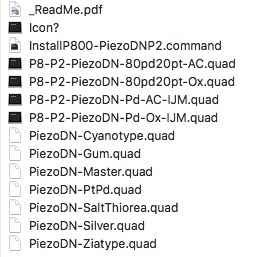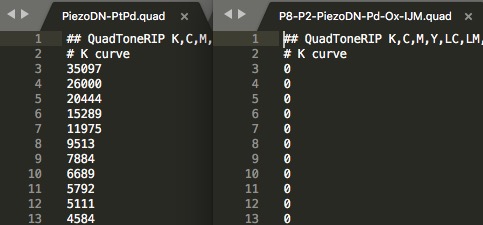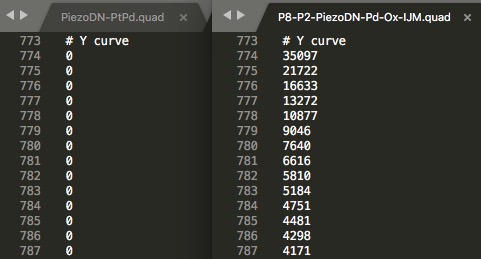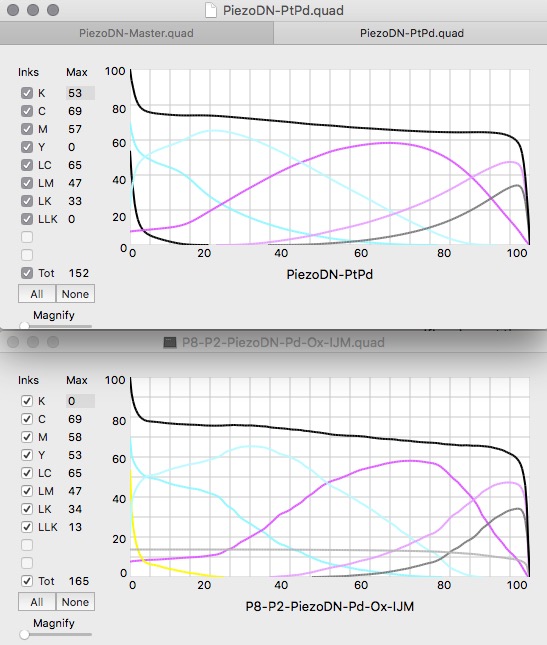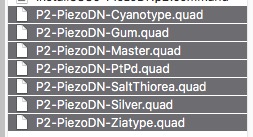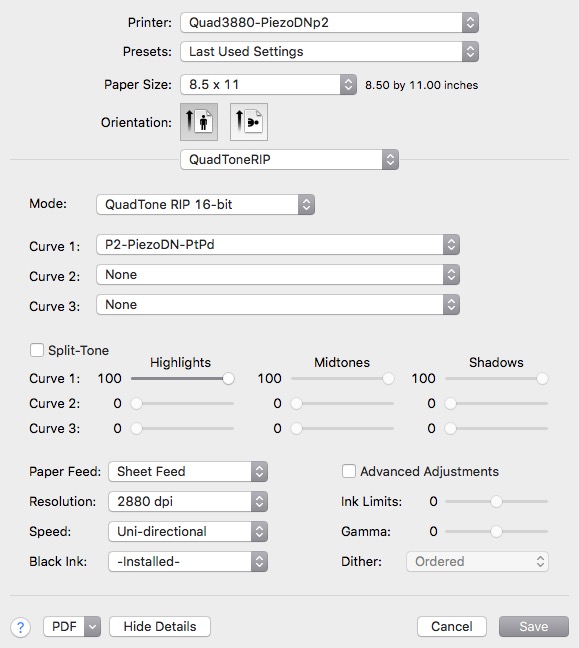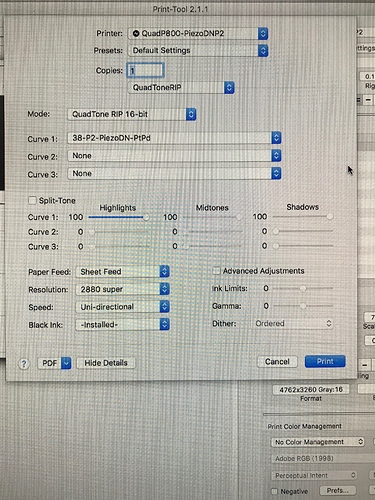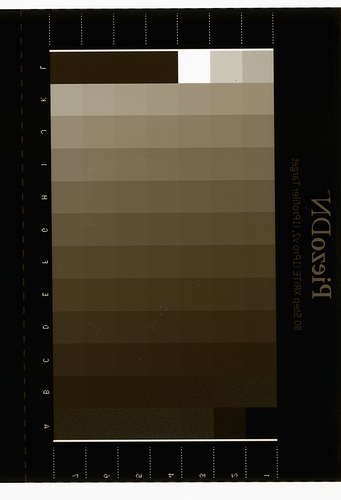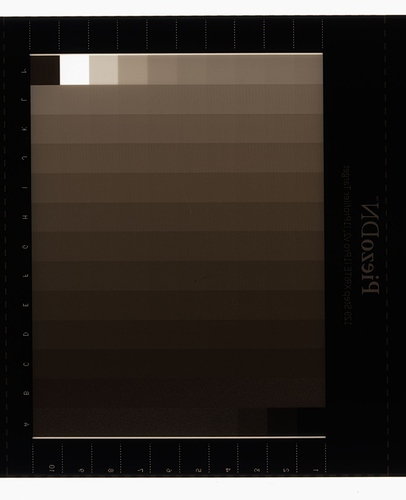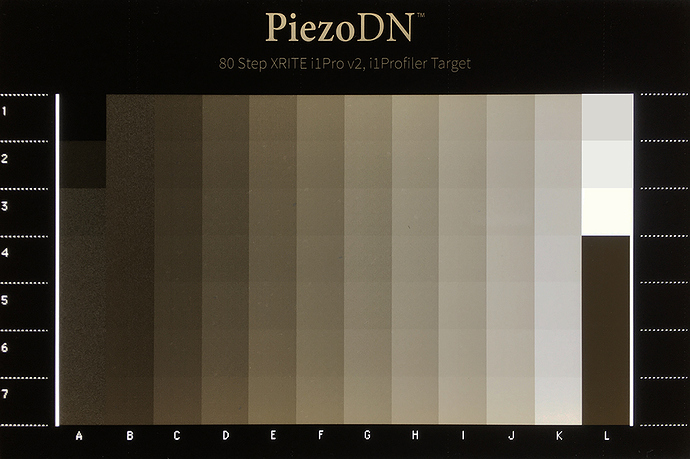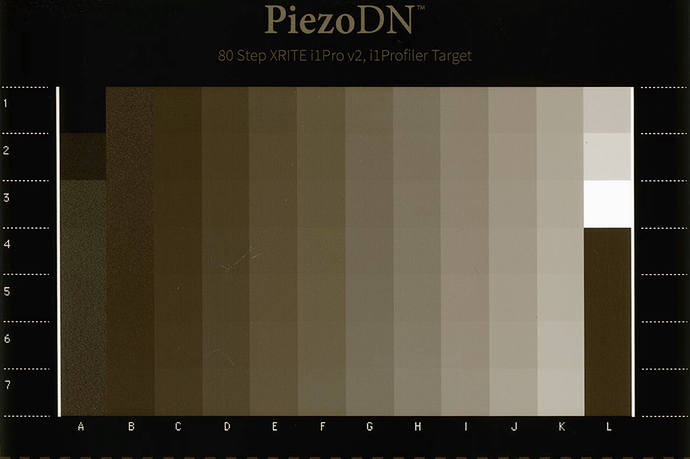Applications/Piezography/Curves/P800-PiezoDN-P2/
I may be being too nitpicky but I don’t see a curve with that name in that folder. Here is what I see:
I’m guessing you mean the 4th up from the bottom, but you could also mean any of the first 4 quads with specific mixes at the end of the name.
Regardless, what I would do next is a test to see if that particular quad could be bad. Make another neg using using the curve named P8-P2-PiezoDN-Pd-Ox-IJM.quad.
WAIT! STOP! HOLD EVERYTHING!
Oh dear! @PiezographySupport we have a problem. I just opened up PiezoDN-Master and PiezoDN-PtPd from this folder (Curves > P800-PiezoDN-P2) and thought how odd — they are exactly the same — I mean identical. Then I opened them in Curve View and thought how odd— they seem to be using the K channel rather than the Y channel. Then just to be sure I opened P8-P2-PiezoDN-Pd-Ox-IJM and it clearly is using Y rather than K.
So it looks like only the first 4 curves in this folder are actually P2 curves. The rest of them are regular K6/K7 curves that were not converted to P2. I notice also that the P8-P2… curves are using GO while the others are not.
I think something got mixed up or misplaced.
So Jesse - just to be clear - make another neg using P8-P2-PiezoDN-Pd-Ox-IJM.quad and I bet the problem will be solved. Or better yet, download and install this curve into your P800-PiezoDN-P2 folder and use it:
P2-PiezoDN-PtPd.quad (8.2 KB)
Keith
Awesome! Thank you! One thing… I don’t see any of those additional .quad files, I just have the PiezoDN-master, PiezoDN-PtPd, etc, not any of the P8-P2 quad files, the Pd-Ox or variants… where do I get those??
Thanks!
-Jesse-
Actually, for my process, I am going to be using the Na2 PtPd process with an oxalate developer, which curve should I be using?
Thank you,
-Jesse
Hi Jesse,
Those files may be holdovers from earlier versions of PiezoDN. The installation process was designed so that an update does not delete any curves already there. This is especially important for those of us who make our own.
Here’s what you can do: Delete the non-P2 quads from your P800-PiezoDN-P2 folder. Go to the 3880-PiezoDN-P2 folder, select and copy the quad files, and paste them into the P800-PiezoDN-P2 folder. Do not copy anything but the quads.
I compared a few of the non-P2 quads for the 3880 and P800 and they are the same, so the P2 versions should be as well. Walker can confirm or deny this. ![]()
For your process, start with P2-PiezoDN-PtPd.quad. Expect to make at least 1 custom linearization for your conditions (paper, metal mix, developer, workroom environment, etc). Any change will require a new linearization to get optimum results. (It’s similar to adjusting the amount of restrainer to get the range you want from film negatives of varying contrast.) Theoretically, under ideal conditions by which I mean that your ferric oxalate is in perfect condition (no ferrous ions), you shouldn’t need Na2 or any other restrainer at all. In the real world however this is seldom the case. But it is best to use as little restrainer as possible to prevent fog in the highlights. For an 8x10-ish print (80-100 sq in) this means 1 drop of 1.25% Na2 added to 1.5ml of total solution (0.75ml each of FO and Pd). I can give approximate drop counts if you want but drops are imprecise. Pipettes measuring in microliters (ul) are best.
Also, since you mention Na2 Pt/Pd process, be aware that sodium hexachloroplatinate (Na2PtCl6) is incompatible with the standard Pt solution potassium tetrachloroplatinate (K2PtCl4), often resulting in grungy highlights. Use Na2 with palladium only.
Finally, if you find your prints plagued by black spots as has been the case periodically with my Pt/Pd work for going on 30 years now, consider switching to the Malde-Ware chemistry which uses ammonium ferric oxalate as the sensitizer. I have gradually made that change over the last 2 years and have not had a single black spot using it.
Keith
This is fantastic information, thank you! I’ll start on that now. I have those microliter pipettes I use to add Na2 according to Dick Arentz’s table in the second edition of his book  how many microliters do you suggest for 1.5ml of solution?
how many microliters do you suggest for 1.5ml of solution?
Cheers,
-Jesse-
Do I need to do a reinstall of the InstallP800-PiezoDNP2.command?
Yes - that will add the new curves - sorry I forgot to mention that. Before you do that though, navigate to
HD > Library > Printers > QTR > quadtone > P800-PiezoDN-P2
and delete anything that you find there. This will remove the previously installed curves that are causing your problem.
Also useful to know: If there are curves in any folder that you don’t want to install, simply make a subfolder (I call mine not installed) and move them to it. The install command will not see them.
Keith
I contributed to that book! Mostly chapter 5. Did you ever take a workshop from Dick? I used to assist sometimes back in the mid-90’s to mid-00’s.
Personally, I used a serial dilution method of managing Na2 using dilutions of 20, 10, 5, 2.5, 1.25, 0.625, and 0.3125%. Table 7.4 on p.59 of the book is more or less what I do, though I think some of the math in the table headings (at the top) is unnecessarily confusing.
Dick preferred to use full-strength 20% Na2 drawing the necessary volume with a pipettor. Back then there were no inexpensive pipettors available here. Several hundred $s for one was typical. Now we can get them for about $25 or so. In Table 7.3 on p.59 of the book, you would use the column for negative DR 1.85.
I found that 1 typical drop of Na2 is 64ul, so I modified my standard 2ml formula of 1ml FO + 1ml Pd + 1 drop 1.25% Na2 to 1000ul FO + 1000ul Pd + 64ul 1.25% Na2. This is easy to scale to whatever volume you need. For example 1.5ml would be 750ul FO + 750ul Pd + 48ul 1.25% Na2.
If you want to use 2.5 % Na2, the same strength would require 1/2 the volume compared to 1.25%. 64ul of 1.25% would be 32ul of 2.5%, 16ul of 5%, 8ul of 10%, or 4ul of 20%.
This is a bit different than Arentz’s table 7.3 where he indicates 2ml of coating solution would require 20ul (0.020ml) of 20% Na2. All I can say to this is that, as always with these printing processes, your mileage may vary, and mine definitely did. 
Keith
I did the above, I even reinstalled Piezography DN and re-did the above… I still get the issue. Let me restart my machine
Please show a screenshot of the Print-Tool Page Setup with the curve you are using selected. It should look something like this:
Yep! that looks like my printing options… except I still have the name of the 38* file name…
I printed a new negative on OHP ultra and I still get what looks like a lightening in the final column (in this pic at the bottom)… here’s a scan of the neg as a transparency:
can you confirm whether this is what it’s supposed to look like?? I can try printing it this afternoon to make sure I’m not misinterpreting how the stepwedge looks and how it actually prints, but I assume I’m supposed to see a gradual increase in density that translates directly to the print? I’m used to silver based step wedges and it’s a direct visual correlation.
Thanks!
-Jesse-
Something is still off.
I’m wondering where the 38- prefix in the curve name came from. I’m not seeing it. I did just download and update my PiezoDN system since I was having a problem installing my 3880-PiezoDN-P2 printer in order to be able to get as close to your setup as possible not having a P800. (I don’t actually use this printer for negatives (long story) - I have another 3880 with an experimental ink set just for negatives.)
My thinking was that since the curve you were using before was using the MK ink in the K channel rather than the PK ink in the Y channel, getting that straightened out would hopefully solve this problem but apparently there is more to it. Now I’m wondering if you might have somehow gotten your shades 2 and 3 switched, or something like that. Not likely I know. Actually looking at the ink separation page from yesterday I can see that placement is correct.
Looking closely at the target it looks like there is no separation at all from A3 through B2. I gotta admit that one of my 3880s proved to be impossible to use for negatives for reasons that the grittiness you I see in those steps remind me of, though it makes great prints on paper with the same K6-Carbon-P2 setup you are using. I use a K6-Carbon inkset on a 1430 with PK installed for negs so there is nothing wrong with the inks.
I think printing this target will produce exactly what we would expect from looking at it.
Please upload the curve that you are using 38-P2-PiezoDN-PtPd so I can take a closer look at it.
Keith
Here’s a scan using the P2-PiezoDN-PtPd.quad you included in your reply above:
…seems better? It’s still a bit gritty.
Here’s the quad you asked for:
P2-PiezoDN-PtPd.quad (8.2 KB)
-Jesse-
That latest step wedge definitely looks the closest so far, but I’m still seeing that grittiness in that last column and it doesn’t seem quite right. I’m hesitant to drop another bunch of cash on a new printer for negatives as this hasn’t been the most confidence inspiring journey, but should I consider that and keep the P800 for positive prints and get a different printer for negatives? Of the new printers, which would be the best for negatives?
anyway, let’s see if we can get this one going… the printer is currently using the MK mode… should I try PK mode to switch? Like you, I thought the inks were correct looking at the ink separation page…
Any other thoughts?
Just tried PK mode, get the same result 
I have two spare ink carts left, perhaps I should try a fresh cart of 2 and 3? Walker also sent a new bottle of PK, I’ll replace that and flush.
-Jesse-
With a P2 ink configuration you never should have PK active. In case there is still confusion about this, let me try to explain. In a “normal” ink configuration, be it Epson OEM inks, Cone Colors, or Piezo K7, the K channel selects which black ink, MK or PK, is active. Only one can be active at a time since they share a single channel in the head. When you do a black ink change, a switch in the damper block (I think of it as something like a switch on a railroad track) determines which ink line is being used for the K channel. With a Piezo P2 setup, this switching between blacks is unnecessary because the MK is in the usual MK position, but PK is in the Y position. (The cart in the PK channel is filled with PiezoFlush but only to keep it from drying out - it is never used.) If you are in “PK mode”, this means that any quad you use that has the K channel active will deposit PiezoFlush where MK ink is called for. This would only happen with prints on matte papers that use MK ink. Negatives, and prints on non-matte papers, use PK which is in the Y channel, so nothing should be coming out of the K channel at all.
In the case of your negatives, the first curve you were using was not a P2 curve so it was using MK ink since that is what is in the K channel. If you use that curve in PK mode it will use PiezoFlush and there will be no black at all since the Y channel would not be used. When I realized last night that the curve from your P800-P2 installation was not actually a P2 curve, I thought that was the cause of the problem, but apparently there is more to it than just that. Now we have to figure out what that is.
This negative looks better sort of, until I open it up large and see the B row (column if rotated to read correctly) is darker on the left (bottom) than on the right (top). And there’s still a flat section in column A. It is also overall darker. My head is starting to hurt!
I think I’m going to make a neg on my 3880 with the P2 K6-Carbon setup using the P2-PiezoDN-PtPd curve and see what happens. The 3880 and P800 are similar enough that any differences should be minor. I’ll get back to you later when I have something.
Keith
Those 2 quads should be the same.
Ok, thank you for the thorough explanation. I’ve switched it back. Yeah, this is a doozy.
Thank you for looking into it.
-Jesse-
What I get with the same quad and the same target is not quite the same as your but close. Here are pictures of mine (please excuse the loss of saturation towards the right edge - a quirk of my phone camera I guess) and yours flipped rotated and adjusted a little to get a reasonable match.
Mine
Yours
This means that:
- our printers suffer from a similar malaise which seems to afflict the tonal range if 2-14% in the target file
- something is seriously wrong with the quad
- something odd about the behavior of the Carbon ink set
- ???
But:
- my 1430 does just fine with this ink set
- others are doing well making negs with both the 3880 and the P800
- ???
Wish I knew where to go from here. This was a dead-end for me the first time and I struggled with it on and off for almost 2 years before giving up. Fortunately, I had another printer I could use for making negs. Maybe someone else out there has solved this problem.
For @PiezographySupport: The non-P2 curves that are in the P800-PiezoDN-P2 folder are still a problem regardless. I just downloaded and reinstalled today to see if this has been fixed (and also to fix an installation issue for my 3880-P2 machine) but the correct P2 curves are still missing for the P800.
Keith
